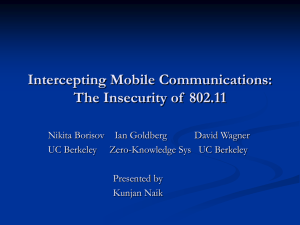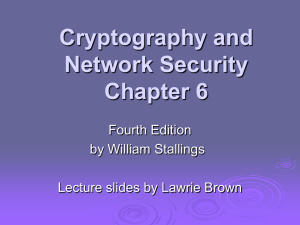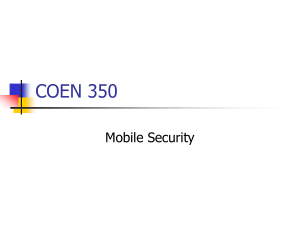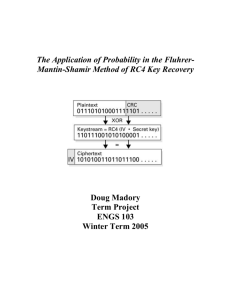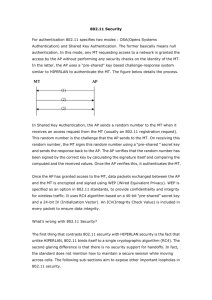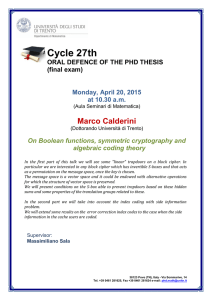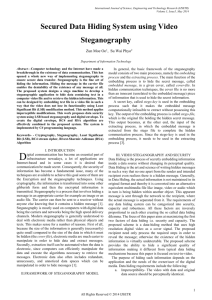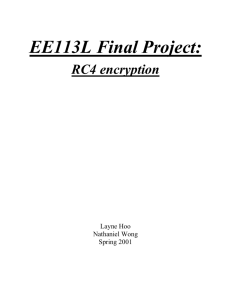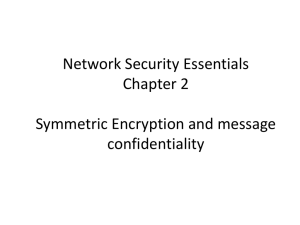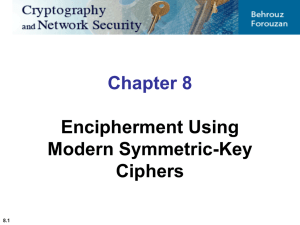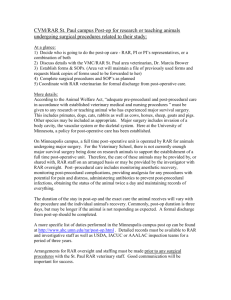Stream Cipher
advertisement
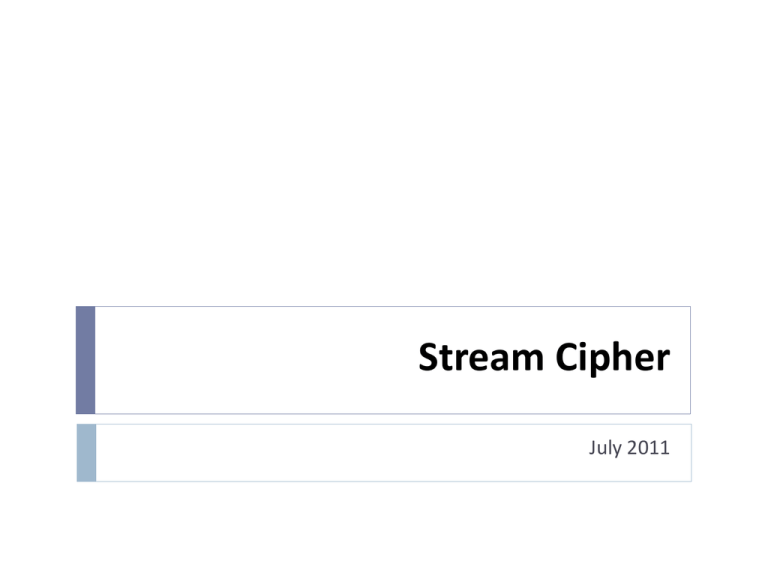
Stream Cipher July 2011 Topics One-Time-Pad Random Number Generator Stream Cipher RC4 RC4 and WEP One-Time Pad Developed by Gilbert Vernam in 1918, another name: Vernam Cipher The key • a truly random sequence of 0’s and 1’s the same length as the message use one time only The encryption • adding the key to the message modulo 2, bit by bit. Encryption c i mi ki Decryption mi c i ki mi ki ci i 1,2,3,... i 1,2,3,... : plain-text bits. : key (key-stream ) bits : cipher-text bits. Example Encryption: 1001001 1000110 1010110 0110001 0011111 1110110 plaintext key ciphertext Decryption: 0011111 1110110 1010110 0110001 1001001 1000110 ciphertext key plaintext One-Time pad practical Problem Key-stream should be as long as plain-text Difficult in Key distribution & Management Solution : Stream Ciphers Key-stream is generated in pseudo-random fashion form Relatively short secret key Stream Cipher Model Output function appears random Si+1 Si Si F G F Initial state, output and state functions are controlled by the secret key. G mi ki : state of the cipher at time t = i. : state function. : output function. ci Random Numbers Many uses of random numbers in cryptography In all cases its critical that these values be Nonce as Initialize Vector Session keys Public key generation Keystream for a one-time pad statistically random, uniform distribution, independent unpredictability of future values from previous values Care needed with generated random numbers Topics One-Time-Pad Random Number Generator Stream Cipher RC4 RC4 and WEP Pseudorandom Number Generators (PRNGs) Often use deterministic algorithmic techniques to create “random numbers” although are not truly random can pass many tests of “randomness” Known as “Pseudorandom Numbers” Created by “Pseudorandom Number Generators (PRNGs)” Random & Pseudorandom Number Generators PRNG Requirements Randomness Unpredictability uniformity, scalability, consistency forward & backward Unpredictability use same tests to check Characteristics of the seed Secure if known adversary can determine output so must be random or pseudorandom number Using Block Ciphers as PRNGs For cryptographic applications, can use a block cipher to generate random numbers Often for creating session keys from master key CTR Xi = EK[Vi] OFB Xi = EK[Xi-1] Stream Ciphers Generalization of one-time pad Stream cipher is initialized with short key Key is “stretched” into long keystream have a pseudo random property Keystream is used like a one-time pad XOR to encrypt or decrypt Topics One-Time-Pad Random Number Generator Stream Cipher RC4 RC4 and WEP Stream Cipher Structure Randomness of stream key completely destroys statistically properties in message Must never reuse stream key otherwise can recover messages Stream Cipher Properties Some design considerations are: long period with no repetitions statistically random depends on large enough key large linear complexity Properly designed, can be as secure as a block cipher with same size key Benefit : usually simpler & faster Topics One-Time-Pad Random Number Generator Stream Cipher RC4 RC4 and WEP RC4 Basics A symmetric key encryption algorithm invented by Ron Rivest Variable key size, byte-oriented stream cipher A proprietary cipher owned by RSA, kept secret Code released at the sites of Cyberpunk remailers Normally uses 64 bit and 128 bit key sizes. Used in SSL/TLS (Secure socket, transport layer security) between web browsers and servers, IEEE 802.11 wirelss LAN std: WEP (Wired Equivalent Privacy), WPA (WiFi Protocol Access) protocol RC4-based Usage WEP WPA default Bit Torrent Protocol Encryption Microsoft Point-to-Point Encryption SSL (optionally) SSH (optionally) Remote Desktop Protocol Kerberos (optionally) RC4 Block Diagram Secret Key RC4 Keystream Plain Text + Cryptographically very strong and easy to implement Encrypted Text RC4 …Inside Consists of 2 parts: KSA Key Scheduling Algorithm (KSA) Pseudo-Random Generation Algorithm (PRGA) Generate State array PRGA on the KSA Generate keystream XOR keystream with the data to generated encrypted stream KSA PRGA The KSA Use the secret key to initialize and permutation of state vector S, done in two steps 1 2 for i = 0 to 255 do S[i] = i; T[i] = K[i mod(|K|)]); [S], S is set equal to the values from 0 to 255 S[0]=0, S[1]=1,…, S[255]=255 [T], A temporary vector [K], Array of bytes of secret key |K| = Keylen, Length of (K) j = 0; for i = 0 to 255 do j = (j+S[i]+T[i])(mod 256) swap (S[i], S[j]) • Use T to produce initial permutation of S • The only operation on S is a swap; S still contains number from 0 to 255 After KSA, the input key and the temporary vector T will be no longer used The PRGA Generate key stream k , one by one XOR S[k] with next byte of message to encrypt/decrypt i = j = 0; While (more_byte_to_encrypt) i = (i + 1) (mod 256); j = (j + S[i]) (mod 256); swap(S[i], S[j]); k = (S[i] + S[j]) (mod 256); Ci = Mi XOR S[k]; Sum of shuffled pair selects "stream key" value from permutation RC4 Lookup Stage The output byte is selected by looking up the values of S[i] and S[j], adding them together modulo 256, and then looking up the sum in S S [S[i] + S[j]] is used as a byte of the key stream, K http://en.wikipedia.org/wiki/File:RC4.svg i = j = 0; While (more_byte_to_encrypt) i = (i + 1) (mod 256); j = (j + S[i]) (mod 256); swap(S[i], S[j]); k = (S[i] + S[j]) (mod 256); Ci = Mi XOR S[k]; Detailed Diagram Overall Operation of RC4 Decryption using RC4 Use the same secret key as during the encryption phase. Generate keystream by running the KSA and PRGA. XOR keystream with the encrypted text to generate the plain text. Logic is simple : (A xor B) xor B = A A = Plain Text or Data B = KeyStream Topics One-Time-Pad Random Number Generator Stream Cipher RC4 RC4 and WEP RC4 and WEP WEP is a protocol using RC4 to encrypt packets for transmission over IEEE 802.11 wireless LAN. WEP requires each packet to be encrypted with a separate RC4 key. The RC4 key for each packet is a concatenation of a 24-bit IV (initialization vector) and a 40 or 104-bit long-term key. RC4 key: IV (24) Long-term lkey (40 or 104 bits) 29 802.11 frames using WEP Header IV Packetl ICV FCS encrypted • ICV: integrity check value (for data integrity) • FCS: frame check sequence (for error detection) • Both use CRC32 30 WEP Vulnerability WEP protocol has several flaws but not the RC4 itself Short IV length Clear text IV as part of the key 24 bits IV not sufficient 24 bits of every key in cleartext Collect and analyze IVs to extract the WEP key Weak IVs Some generated IVs do not provide enough randomness Can be used to extract the key Q&A
